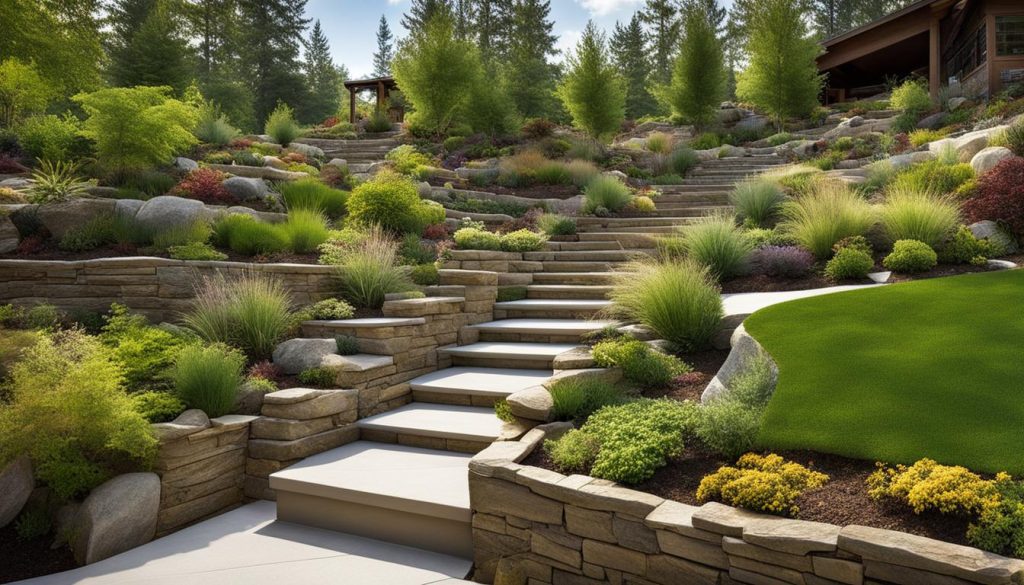Welcome to our comprehensive guide to slope landscaping! If you’re a property owner with hilly terrain, you know the challenges that come with maintaining a slope. But fear not, we have expert solutions that will help you turn your challenging terrain into a beautiful and functional landscape. Let’s dive in!
Key Takeaways
- Slope landscaping can be challenging, but there are creative and eco-friendly ways to make the most of your terrain.
- Before starting any landscaping project on a slope, it’s essential to assess the terrain and understand the unique challenges it presents.
- Erosion control is a crucial aspect of slope landscaping, and using methods like retaining walls and terracing can help stabilize the soil and prevent erosion.
- Choosing the right plants for your slope is key to ensuring the flora thrives and doesn’t contribute to erosion or water runoff.
- Creative design elements can enhance the aesthetic appeal of your slope, including rock gardens, cascading plants, and focal points.
Assessing Your Slope: Understanding the Challenges
Assessing your slope is the first step towards successful slope landscaping. Before jumping into any design ideas, it’s essential to understand the unique challenges that steep slopes present.
Factors to consider when assessing your slope include:
- The slope’s angle and degree of steepness
- The soil type and depth
- Exposure to sun, wind and rain
- Water runoff and drainage patterns
- Accessibility and safety concerns
Each of these factors can impact the design choices you make when landscaping your slope.
Assessing your slope is critical for identifying and addressing any slope challenges that may arise during the landscaping process.
Some of the common slope challenges include:
| Challenge | Description |
|---|---|
| Erosion | Heavy rainfall or wind can cause soil erosion, leading to unstable ground and potential safety hazards. |
| Access | Steep slopes can be challenging to access, making maintenance and upkeep difficult. |
| Drainage | Water can rapidly run down steep slopes, causing damage and erosion. Proper drainage techniques are needed to prevent runoff and protect the slope. |
| Plant selection | Not all plants are suited to steep slopes. Choosing the right plants that can withstand the slope’s unique challenges is essential for a successful landscape design. |
Understanding these slope challenges is key to finding solutions that work for your unique terrain. By assessing your slope and acknowledging any obstacles, you can make informed decisions and create a landscape that is both beautiful and functional.
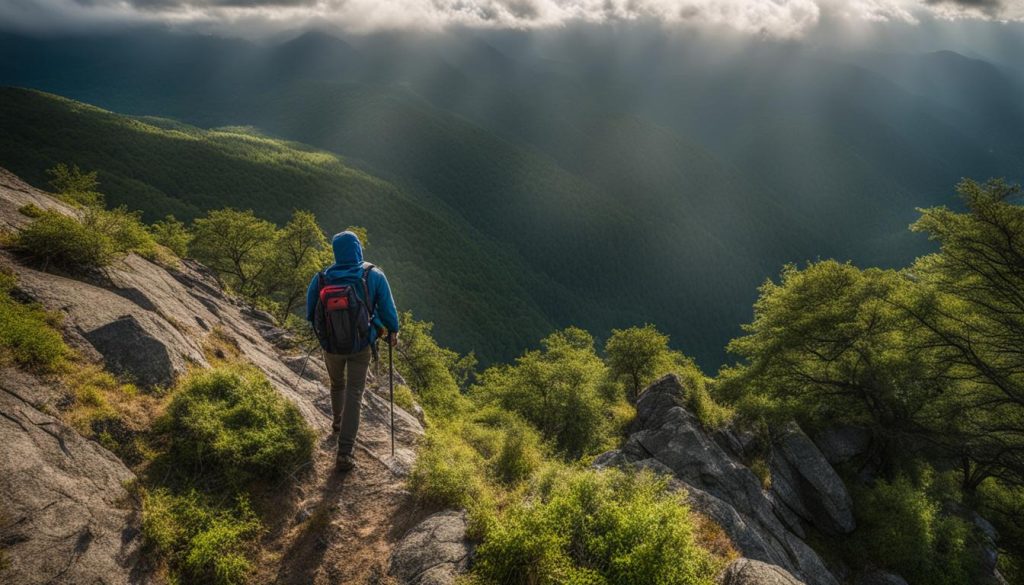
Erosion Control: Preserving Your Slope
Steep slopes are prone to erosion, which can cause damage to the surrounding environment and property. Therefore, it’s essential to take measures that preserve the integrity of your slope.
Retaining Walls
Retaining walls are a popular solution for slopes. They hold back soil and reduce erosion, preventing further damage. Retaining walls can be made from various materials such as concrete, brick, and stone. They not only protect against erosion but also offer structural support, making them an ideal choice for steep slopes.
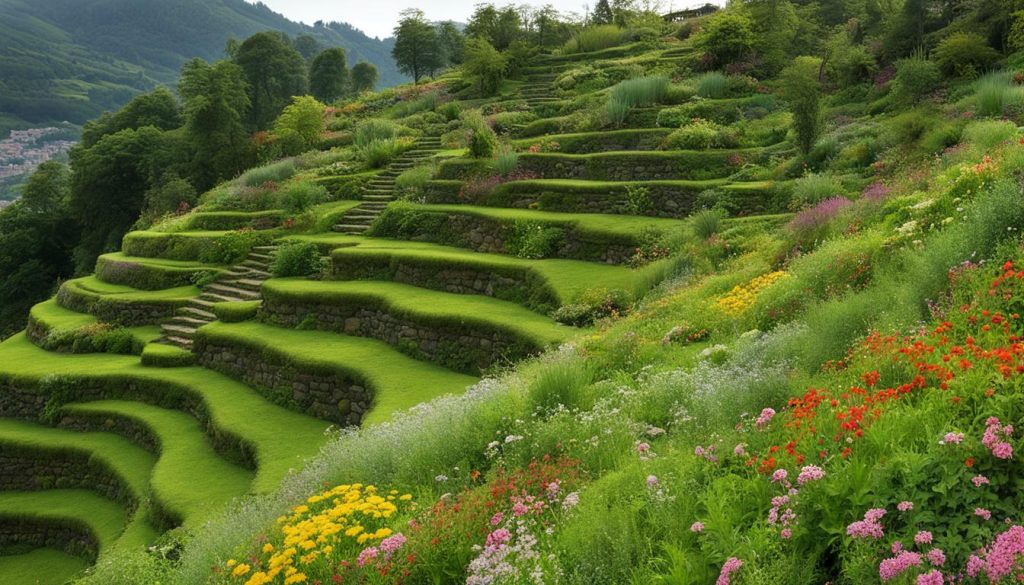
Terracing
Terracing is another technique for preventing soil erosion and creating a multi-level landscape. This method involves building steps or levels into the slope and filling them with soil to create a flat surface. Terracing helps to prevent erosion by breaking up the slope into smaller sections, reducing the flow of water down the slope. It also helps to create an attractive landscape that can be used for planting and gardening.
Planting Techniques
Planting the right vegetation is a vital aspect of slope preservation. Groundcover plants, such as creeping phlox, and deep-rooted trees and shrubs help to stabilize the soil and prevent erosion. Native plants are an effective option as they are adapted to the local climate and soil, making them easier to maintain. Plants with shallow roots like annual flowers should be avoided as they do not anchor the soil and contribute to erosion.
Professional Assistance
If you’re unsure about which erosion control method is best for your slope, or you need help with the installation process, you can engage the services of a slope landscaping expert. They will assess your slope and recommend the most suitable erosion control technique for your property. A professional landscaper will also ensure the necessary permits are obtained before installing the erosion control measures and provide maintenance services to keep your slope in top condition.
Plant Selection: Choosing the Right Flora for Slopes
When it comes to planting on slopes, it’s important to choose the right flora that can thrive in challenging terrain. The plants you select should be able to withstand soil erosion, water runoff, and varying sunlight exposure. Here are some factors to consider when selecting plants for your slope:
- Root depth: Plants with deep roots can help stabilize the soil and prevent erosion.
- Water needs: Choose plants that can tolerate drought conditions, as well as heavy rainfall and runoff.
- Sun exposure: Consider the amount of sunlight your slope receives throughout the day to ensure the plants you choose can thrive in those conditions.
- Maintenance requirements: Select plants that are easy to care for and don’t require a lot of pruning or upkeep.
When it comes to choosing the right plants for your slope, native plants are often the best choice. They are adapted to local soil and weather conditions, and require maintenance. Some great options for slope landscaping include:
| Plant Name | Plant Type | Benefits |
|---|---|---|
| Manzanita | Shrub | Low water usage, fire-resistant, attractive foliage and flowers |
| California Fescue | Grass | Drought-tolerant, low maintenance, attractive seed heads |
| Creeping Oregon Grape | Ground cover | Drought-tolerant, evergreen, attracts pollinators |
| Coastal Sage | Shrub | Drought-tolerant, low maintenance, attracts pollinators |
These are just a few examples of the many plants that are suitable for slopes. When selecting plants for your slope, it’s important to keep in mind the specific conditions of your location and consult with a landscape designer or professional if you have any questions or concerns.
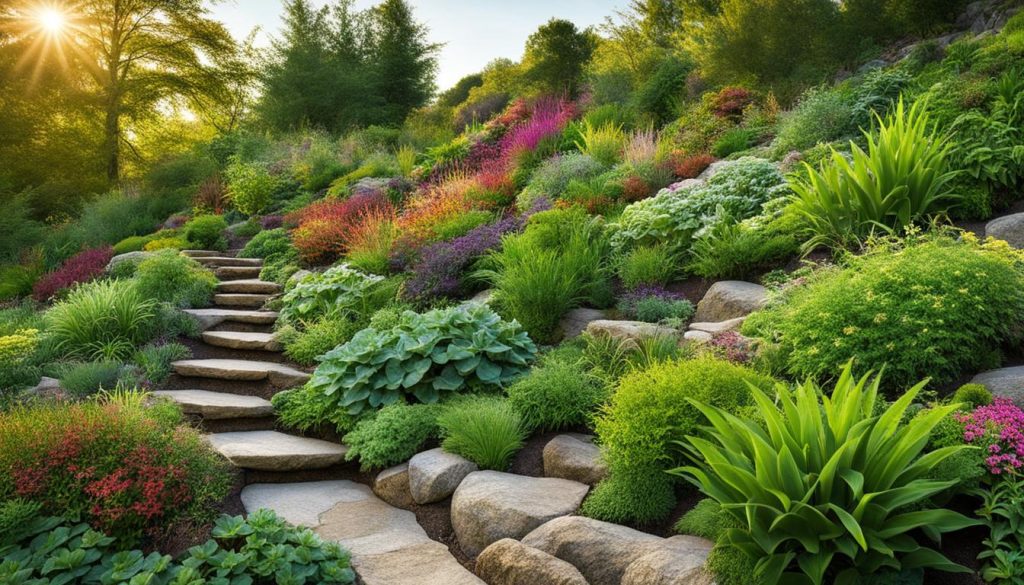
Creative Design: Enhancing the Aesthetic Appeal
When it comes to landscaping steep slopes, creative design can make all the difference. Not only can it enhance the aesthetic appeal of your property, but it can also serve practical purposes such as minimizing erosion and improving drainage.
One way to add visual interest to a slope is by incorporating a rock garden. Not only does it add texture and dimension, but it can also serve as a natural retaining wall to prevent soil erosion. Consider using a variety of rocks in different sizes and textures for added interest.
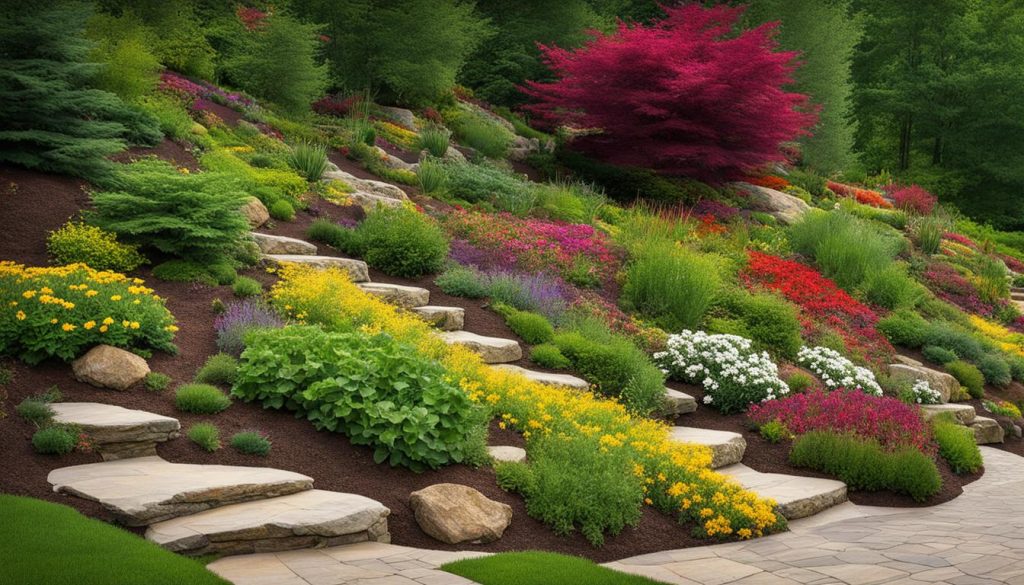
Cascading plants are another way to add visual interest while also serving a practical purpose. These plants not only look beautiful, but they help stabilize the soil and prevent erosion. Consider plants such as Creeping Jenny, Thyme, or Sedum for their cascading effect.
Strategically placed focal points such as benches, sculptures, or even birdhouses can add interest and draw the eye up the slope. These elements can also serve as a distraction from any imperfections or unevenness in the slope.
Creating Levels
Creating levels on the slope can also add visual interest while creating usable space. Terracing is a popular option, creating flat areas on the slope that can be used for planting, sitting, or even a small garden. Retaining walls can also be used to create different levels, adding depth and dimension to the slope.
Colour and Texture
When selecting plants for a slope, consider the colour and texture of the foliage. Different hues and textures can add depth and visual interest to the slope. For example, ornamental grasses can add texture and movement, while colourful perennials can add pops of colour. Be sure to select plants that are suitable for the slope’s sun exposure and soil conditions.
By using creative design techniques, you can transform a steep slope into a beautiful and functional part of your property.
Water Management: Addressing Drainage Issues
Managing water on steep slopes can be challenging, but there are techniques that can help prevent erosion and redirect water runoff.
Installing Drainage Systems
One effective way to address drainage issues is by installing a drainage system. This can include French drains, which use a perforated pipe and gravel to redirect water away from the slope, or surface drains, which collect water that flows over the surface of the slope and redirect it to a designated area.
When installing a drainage system, it’s important to take factors such as slope angle, soil type, and water flow into consideration. A slope landscaping expert can help determine the best type of drainage system to use and ensure it’s installed correctly.
Creating Swales
Another technique for managing water on slopes is by creating swales. Swales are shallow ditches or depressions built along the contour of the slope that collect and redirect water, allowing it to slowly percolate into the soil.
Swales can be created using various materials such as rocks, wood, or plants. They can also be designed to enhance the aesthetic appeal of the slope while providing effective water management.
Implementing Rain Gardens
Rain gardens are another effective technique for managing water on slopes. They are designed to collect and absorb rainwater, allowing it to slowly infiltrate into the soil and recharge the groundwater.
To create a rain garden, plants are selected for their ability to tolerate both wet and dry conditions. They are then planted in a shallow depression that collects water from the slope. The depression is filled with a special soil mix that helps filter the water and promote infiltration.
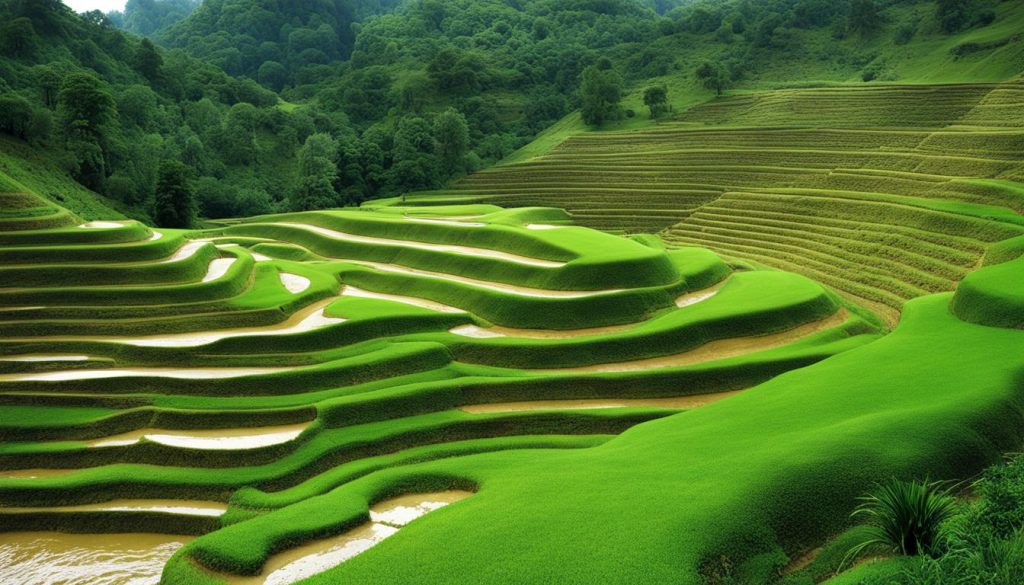
When addressing drainage issues on steep slopes, it’s important to take a holistic approach that considers the unique characteristics of the terrain and the surrounding environment. By implementing proper water management techniques, you can help preserve and protect your slope for years to come.
Professional Assistance: Engaging a Slope Landscaping Expert
If you’re feeling overwhelmed by the challenges of slope landscaping, don’t worry – you’re not alone! Many homeowners find this type of terrain difficult to work with. That’s where a slope landscaping expert can help.
Benefits of Hiring a Professional
First and foremost, a slope landscaping expert has the knowledge and experience to tackle even the most challenging projects. They can assess your terrain, recommend the best erosion control methods and plant selections, and design a beautiful landscape that enhances the natural contours of your slope.
Another benefit of working with a professional is the time and effort you’ll save. Slope landscaping can be a major undertaking, and it’s not uncommon for homeowners to become frustrated or overwhelmed. A slope landscaping expert can take care of the heavy lifting, so you can sit back and enjoy the finished product.
Finding the Right Expert for Your Project
When searching for a slope landscaping expert, it’s important to do your research. Look for someone with experience working with hilly terrain, and ask for references or examples of their previous work. You should also check their credentials, such as whether they are licensed, insured, or a member of a professional organization.
Once you’ve found a few potential candidates, set up consultations to discuss your project in more detail. This will give you a chance to gauge their knowledge and expertise, ask questions, and get a sense of whether they are a good fit for your needs.
Ultimately, working with a slope landscaping expert can help you achieve a beautiful and functional landscape that you’ll love for years to come. Don’t hesitate to contact us – we’re here to help you make the most of your challenging terrain.
FAQ
What are some expert solutions for slope landscaping?
In this article, we will explore creative and environmentally friendly techniques to help you make the most of your hilly terrain.
How should I assess my slope before landscaping?
It’s important to understand the challenges your slope presents. Factors to consider include terrain assessment and unique issues that may arise with steep slopes.
How can I control erosion on my slope?
Various erosion control methods, such as retaining walls, terracing, and planting techniques, can stabilize the soil and prevent erosion on your slope.
What should I consider when selecting plants for my slope?
Not all plants are suitable for slopes. Factors to consider when selecting flora include soil erosion, water runoff, and maintenance requirements.
Are there any creative design ideas for enhancing the aesthetic appeal of slopes?
Yes! We’ll discuss creative ideas such as rock gardens, cascading plants, and strategically placed focal points to enhance the visual appeal of your slope.
How can I manage water drainage on my slope?
Proper water management is crucial for slopes. Techniques such as installing drainage systems, creating swales, and implementing rain gardens can address drainage issues.
Should I consider hiring a professional slope landscaping expert?
If you’re unsure about tackling slope landscaping on your own, engaging a professional expert can be beneficial. We’ll discuss the benefits and provide tips for finding the right expert for your project.

